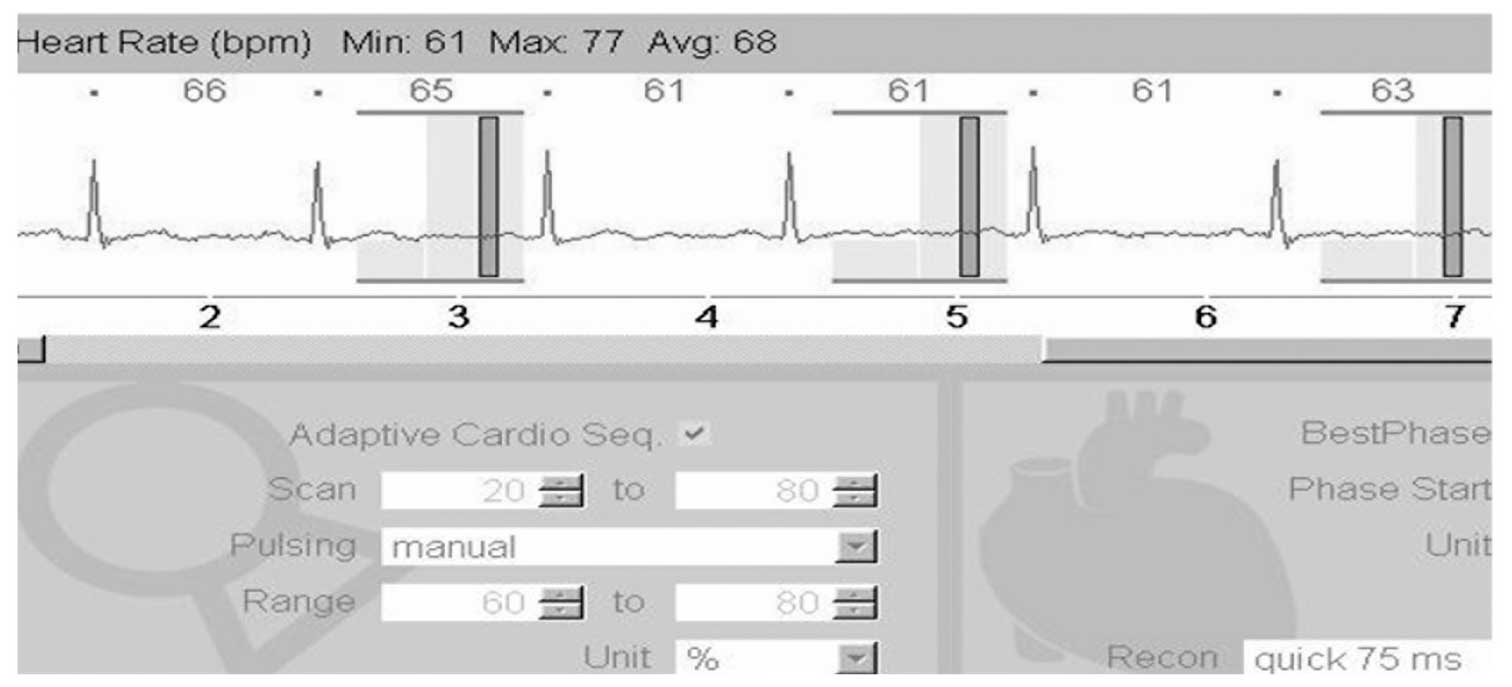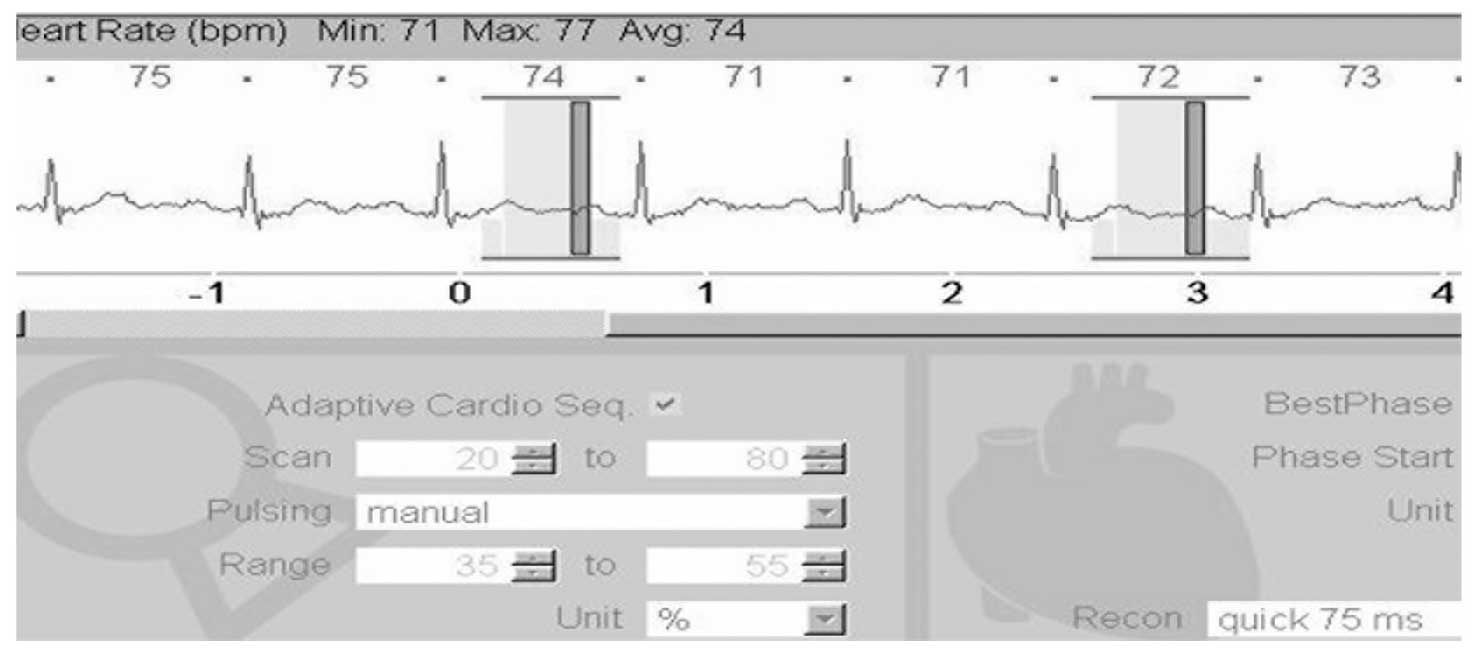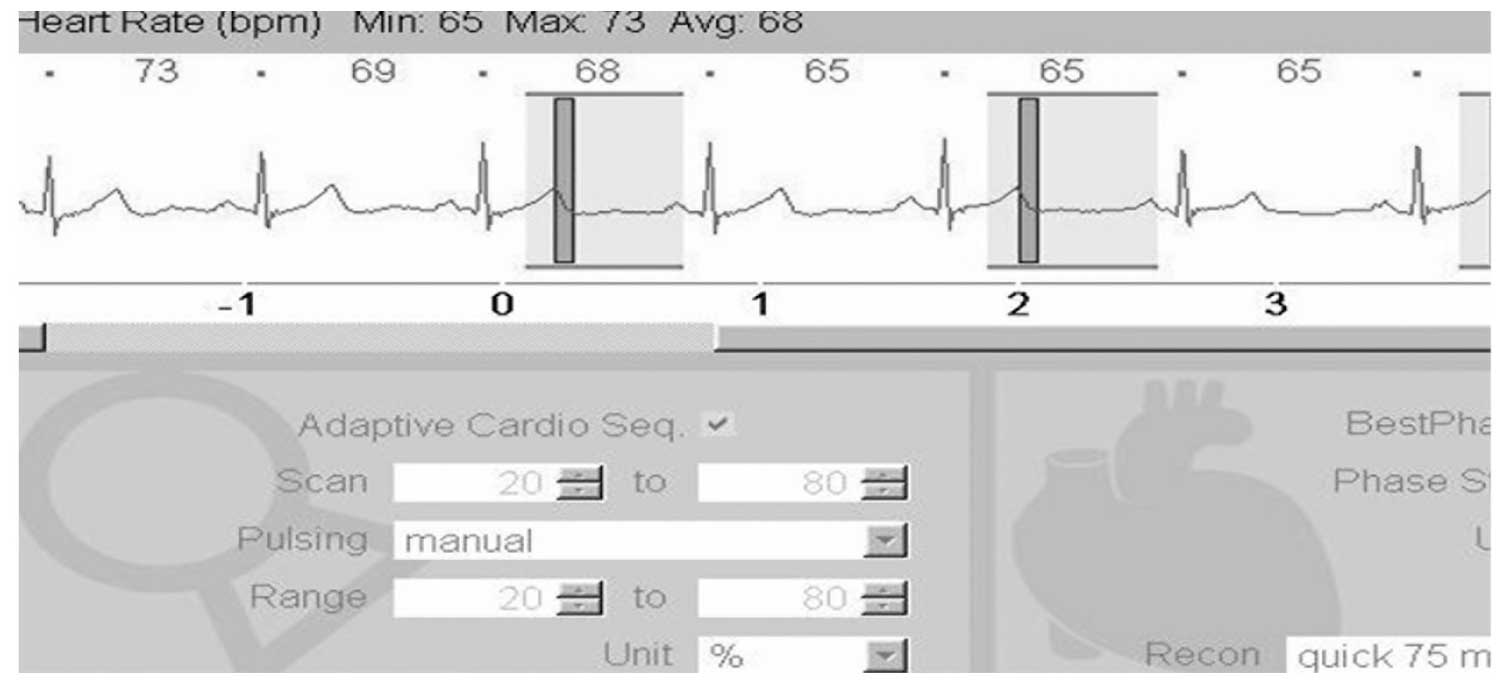Dose study of electrocardiogram automatic tube current modulation technology in prospective coronary computed tomography angiography scans of overweight patients
- Authors:
- Published online on: April 7, 2015 https://doi.org/10.3892/etm.2015.2412
- Pages: 2384-2388
Abstract
Introduction
At present, there are two scanning modes for computed tomography coronary angiography (CTCA); prospective and retrospective electrocardiogram (ECG)-gated scanning. Retrospective ECG-gated spiral scanning requires higher doses of radiation than prospective scanning (1,2). Prospective sequential scanning is able to effectively reduce the radiation dose required for a narrow scanning window, which is increasingly used in CTCA examinations (3–5). However, research is mostly focused on low-dose adaptive sequential sequencing (6). There are a limited number of studies that investigated how radiation doses may be optimized according to changes in the heart rate in ECG pulsing windows of prospective sequential CTCA scanning. Thus, further research is required into methods of reducing the radiation dose of a CTCA scan, while ensuring the image quality of the coronary artery remains sufficient. This is particularly important for overweight [body mass index (BMI) of >24] patients who typically require higher radiation doses in order to obtain high quality images. In the present study, overweight patients were examined using ECG-gated automatic tube current modulation (ATCM) technology in prospective sequential scanning. The dose and exposure times were adjusted according to changes in the heart rate, and the feasibility of the radiation dose and imaging of the coronary arteries were compared.
Materials and methods
Patients
Between March and August 2013, patients suspected of having coronary heart disease were recruited to undergo a CTCA examination in the Fifth Affiliated Hospital of Xinjiang Medical University (ürümqi, China). A total of 40 patients were recruited, of which 12 were female and 28 were male. Patient age ranged between 32 and 65 years, with an average age of 55.6 years. The BMI scores ranged between 25.6 and 30. Patients were divided randomly into two groups. Group A consisted of 20 patients, 14 male and 6 female, with an age range of 32–65 years (mean age, 52.8 years) and a mean BMI of 27.8±2.84. For group A patients with heart rates <70 bpm, the scanning range was 20–80% R-R interval and the patients received a full dose of X-rays for 60–80% of the R-R interval. In the group A patients with heart rates >70 bpm, the scanning range was 20–80% R-R interval and the patients received a full radiation dose for 35–55% of the R-R interval. For group B patients (male, 17; female, 3; age range, 33–62 years; average age, 57.6 years; average BMI, 28.08±1.96) with any heart rate, the scanning range was 20–80% of the R-R interval and patients received full-dose radiation for the entire scan. The two groups presented stable heart rates prior to examination. Image quality and radiation dose were compared between the two groups.
Patients provided written consent prior to all procedures. Patients with severe liver/kidney dysfunction, allergy to iodine contrast agent, decompensated cardiac insufficiency or those that were unable to hold their breath were excluded from the study.
Equipment and scanning method
Patients underwent respiratory training prior to scanning of the entire heart region by ECG-gated detection, using a second-generation dual-source computed tomography scanner (SOMATOM Definition Flash; Siemens Healthcare, Munich, Germany). Monitoring levels were set at 1–2 cm under the trachea bifurcation, and the region of interest was selected in the aortic arch. Bolus tracking was used to initiate the automatic scan once the trigger threshold of the 180 HU was reached (delay, 8 sec). An injection of 70–90 ml iopamidol (iodine content, 370 mg/ml; Shanghai Bracco Sine Pharmaceutical Corp. Ltd., Shanghai, China) was administered at a rate of 6 ml/sec. Scanning parameters were as follows: Tube rotation speed, 0.28 r/sec; detector area, 128×0.6 mm; voltage, 120 kV; reconstruction interval, 0.5 mm; and reconstruction thickness, 0.75 mm. The tube current-time product was automatically set according to the patient BMI.
Image quality analysis
Image data were postprocessed by two experienced physicians using a double-blind method. Coronary arteries were divided into 15 segments, following the improved coronary artery segmentation techniques of the American Heart Association (7). The image quality evaluation standards were divided into three grades as follows: Grade I, coronary artery has no artifacts and the contour is clear; grade II, local coronary arteries have artifacts or vasculature is unclear; and grade III, coronary vascular outline is unclear, or the middle segment or the majority of the segments have artifacts. Grade I and II images were sufficient for evaluation and diagnosis, while grade III images were of insufficient quality.
Calculation of X-ray radiation dose
The method used for calculating the effective X-ray radiation dose of the CTCA scans was as follows (8): Effective radiation dose (ED) = dose-length product (DLP) × conversion coefficient of the examined position (K). For example, ED = DLP (mGy·cm) × 0.017 [mSv/(mGy·cm)], when chest conversion coefficient is K=0.017 [mSv/(mGy·cm)].
Statistical analysis
Using SPSS software, version 13.0 (SPSS, Inc., Chicago, IL, USA), the χ2 test was conducted for image quality evaluation of the coronary arteries and the t-test was used for the two independent samples. P<0.05 was considered to indicate a statistically significant difference.
Results
General patient data
Patients underwent a routine sequence examination in addition to optimized ECG tube-current modulation. No adverse reactions were observed. The BMI values in groups A and B were 27.8±2.84 and 28.08±1.96 kg/m2, respectively, and no significant difference was observed between the groups (P>0.05; Table I).
Image quality analysis
There were 505 and 494 coronary artery segments in groups A and B, respectively. The number of patients with an image quality score of grade I in groups A and B was 406/505 (80.4%) and 391/494 (79.1%), respectively. In total, 81/505 (16.0%) patients in group A and 82/494 (16.6%) patients in group B received an image quality score of grade II. With a grade III image quality score, there were 18/505 (3.6%) patients in group A and 21/494 (4.3%) in group B, and no significant difference was identified between the groups. The assessment rates of groups A and B were 96.4 and 95.7%, respectively (P=0.57; Table II). Grade III-quality images were frequently acquired from the middle and distal artery segments. A single patient in group A exhibited heart rate fluctuations that caused the scanning acquisition period to fall out of the full-dose exposure area, increasing image noise. Although the phase was reconstructed, vessel artifacts appeared.
Calculation of the X-ray radiation dose
In group A patients with heart rates <70 bpm (Fig. 1), the scanning range was 20–80% of the R-R interval and patients received full-dose radiation for 60–80% of the R-R interval. For group A patients with heart rates >70 bpm (Fig. 2), the scanning range was 20–80% of the R-R interval and patients received full-dose radiation for 35–55% of the R-R interval. In group A, patients received an X-ray dose that was 20% of the full dose for 20–35% and 55–80% of the R-R interval. In group B, the scanning range was 20–80% of the R-R interval and patients received a full radiation dose for the entire scan (Fig. 3). In the present study, the computed tomography dose index volume (CTDIvol) of group A was 55.57% of that in group B, and the DLP and ED were 66.23 and 66.25% of the group B values, respectively (Table I). No significant difference in image quality was observed between the groups. For patients with a high BMI, selecting a different total dose exposure window according to different heart rates appeared to reduce the required radiation dose.
In group A, the CTDIvol was 28.82±18.00 mGy, the DLP was 406.2±163.3 mGy·cm and the average ED of radiation was 6.91±2.78 mSv. In group B, the CTDIvol was 51.86±10.63 mGy, the DLP was 613.3±197.5 mGy·cm and the average ED of radiation was 10.43±3.36 mSv. Significant differences in CTDIvol, ED, DLP and ED average were observed between the groups (P<0.05). The assessment of image quality for coronary artery CTA segments indicated that there was no significant difference in image quality between the groups.
Discussion
CTCA imaging is used widely in clinical practice, however high radiation doses are potentially harmful and their effects are under increasing investigation (9). The American Food and Drug Administration Commission issued a statement by the American Heart Committee, stating that a 10 mSv dose of CT radiation may cause 1/2,000 patients to develop a malignant tumor (10). Davis et al (11) demonstrated that a higher radiation dose increased the risk of testicular cancer and glioma in patients that underwent CT scans. Therefore, doctors and imaging technicians aim to maintain the quality of coronary artery imaging during CTCA scanning, whilst also limiting the harm caused to the body by excessive X-ray radiation. It is important to design optimized scanning procedures in order to ensure that high quality coronary artery images are obtained using the lowest possible radiation dose. Current methods of controlling dual-source CT radiation dose include automatic mA modulation, variable and intelligent filtering technology, prospective gating control scan mode and phase-selective exposure technology. A report by the American Heart Association concluded that gating scanning technology was the most promising of these technologies (12).
BMI is the internationally recognized system for assessing the degree of obesity in overweight patients. In the case of obese patients, the required X-ray penetration increases with the volume of subcutaneous fat and muscle thickness, therefore the necessary radiation dose may also increase (13). The smaller the radiation dose, the worse the image quality. When BMI is high, an increased tube current is required to ensure image quality (14). However, by using tube current modulation in dual-source CT scanning, the tube current may be automatically adjusted as required, which reduces the X-ray radiation dose administered to patients. In the present study, varying tube currents were administered at different ECG periods. The radiation dose administered in group A following optimization (6.91±2.78) was significantly lower when compared with group B (10.43±3.36) without optimization, with no significant difference in image quality (Figs. 1–3).
Arnoldi et al (15) demonstrated that when using prospective scanning, the required radiation dose is 2.8 mSv, which is markedly lower than the retrospective scanning dose of 18.4 mSv. A prospective series scan is a step-axis scanning mode, which reduces the rate of scan overlap and is therefore able to significantly reduce the necessary radiation dose. However, the radiation dose for patients with a high BMI remains greater compared with patients with a normal BMI, despite the use of routine sequence scanning.
ECG-ATCM scanning is based on the average heart rate prior to the scan, which is used to select a time window in the optimum phase of the cardiac cycle for full-dose exposure. The diastolic period is an important phase of the cardiac cycle and the tube current was full during this period. In addition, tube current was reduced during the systole period and decreased for the remaining period of the scan, with 20% of the full-dose exposure administered in the other heart regions (16,17). Araoz et al (18) previously reported that the scanning range of dual-source CT is 65–70% of the R-R interval for a heart rate ≤70 bpm and 35–40% of the R-R interval for a heart rate >70 bpm.
In the sequence scanning of the present study, for group A patients with a high BMI and a heart rate ≤70 bpm, the scanning range was 20–80% of the R-R interval, and patients received full-dose radiation for 60–80% of the R-R interval. For group A patients with heart rates >70 bpm, the scanning range was 20–80% R-R of the interval, with patients receiving a full X-ray dose for 35–55% of the R-R interval and a 20% X-ray dose for the remainder of the scanning period (20–35% and 55–80% of the R-R interval). In this manner, the required radiation dose may be further reduced. There are drawbacks to this prospective scanning technology, as the data was obtained from only part of the full heartbeat cycle. It cannot undergo ECG editing and cannot evaluate the heart function, particularly in cases of patients with an irregular heartbeat, which may result in a failed scan.
In conclusion, dual-source CT is able to produce high quality coronary artery images (19,20), while exposing patients to relatively low radiation doses. ATCM and alternative technologies, including pitch-heart rate automatic matching, facilitate significant reductions in the radiation dose of CTCA examination compared with standard CTCA. Furthermore, the use of ECG-ATCM in prospective sequence scanning permits the selection of different total dose exposure windows based on patient heart rate. This selectivity may significantly reduce the required radiation dose in overweight patients. In order to obtain satisfactory image quality, doctors and imaging technicians require an extensive understanding of the hazards of ionizing radiation and should aim to achieve low-dose scanning to reduce the exposure of patients to hazardous radiation.
References
|
Shah DJ, Sachs RK and Wilson DJ: Radiation-induced cancer: a modern view. Br J Radiol. 85:e1166–e1173. 2012. View Article : Google Scholar : PubMed/NCBI | |
|
Sodickson A, Baeyens PF, Andriole KP, et al: Recurrent CT, cumulative radiation exposure, and associated radiation-induced cancer risks from CT of adults. Radiology. 251:175–184. 2009. View Article : Google Scholar : PubMed/NCBI | |
|
Husmann L, Valeta I, Gaemperli O, et al: Feasibility of low-dose coronary CT angiography: first experience with prospective ECG-gating. Eur Heart J. 29:191–197. 2008. View Article : Google Scholar : PubMed/NCBI | |
|
Buechel RR, Husmann L, Herzog BA, et al: Low-dose computed tomography coronary angiography with prospective electrocardiogram triggering: feasibility in a large population. J Am Coll Cardiol. 57:332–336. 2011. View Article : Google Scholar : PubMed/NCBI | |
|
Achenbach S, Goroll T, Seltmann M, et al: Detection of coronary artery stenoses by low-dose, prospectively ECG-triggered, high-pitch spiral coronary CT angiography. JACC Cardiovasc Imaging. 4:328–337. 2011. View Article : Google Scholar : PubMed/NCBI | |
|
Abada HT, Larchez C, Daoud B, et al: MDCT of the coronary arteries: feasibility of low-dose CT with ECG-pulsed tube current modulation to reduce radiation dose. AJR Am J Roentgenol. 186:(Suppl 2). S387–S390. 2006. View Article : Google Scholar : PubMed/NCBI | |
|
Austen WG, Edwards JE, Frye RL, et al: A reporting system on patients evaluated for coronary artery disease. Report of the Ad Hoc Committee for Grading of Coronary Artery Disease, Council on Cardiovascular Surgery, American Heart Association. Circulation. 51:(4 Suppl). 5–40. 1975. View Article : Google Scholar : PubMed/NCBI | |
|
Alkadhia H, Stolzmanna P, Scheffel H, et al: Radiation dose of cardiac dual-source CT: the effect of tailoring the protocol to patient-specific parameters. Eur J Radiol. 68:385–391. 2008. View Article : Google Scholar : PubMed/NCBI | |
|
Nickoloff EL and Alderson PO: Radiation exposures to patients from CT: reality, public perception, and policy. AJR Am J Roentgenol. 177:285–287. 2001. View Article : Google Scholar : PubMed/NCBI | |
|
Budoff MJ, Achenbach S, Blumenthal RS, et al: American Heart Association Committee on Cardiovascular Imaging and Intervention; American Heart Association Council on Cardiovascular Radiology and Intervention; American Heart Association Committee on Cardiac Imaging, Council on Clinical Cardiology : Assessment of coronary artery disease by cardiac computed tomography: A scientific statement from the American Heart Association Committee on Cardiovascular Imaging and Intervention, Council on Cardiovascular Radiology and Intervention, and Committee on Cardiac Imaging, Council on Clinical Cardiology. Circulation. 114:1761–1791. 2006. View Article : Google Scholar : PubMed/NCBI | |
|
Davis F, Ilyasova D, Rankin K, et al: Medical diagnostic radiation exposures and risk of gliomas. Radiat Res. 175:790–796. 2011. View Article : Google Scholar : PubMed/NCBI | |
|
Budoff MJ, Achenbach S, Blumenthal RS, et al: American Heart Association Committee on Cardiovascular Imaging and Intervention; American Heart Association Council on Cardiovascular Radiology and Intervention; American Heart Association Committee on Cardiac Imaging, Council on Clinical Cardiology: Assessment of coronary artery disease by cardiac computed tomography: a scientific statement from the American Heart Association Committee on Cardiovascular Imaging and Intervention, Council on Cardiovascular Radiology and Intervention, and Committee on Cardiac Imaging, Council on Clinical Cardiology. Circulation. 114:1761–1791. 2006. | |
|
Slovis TL: CT and computed radiography: the pictures are great, but is the radiation dose greater than required? AJR Am J Roentgenol. 179:39–41. 2002. View Article : Google Scholar : PubMed/NCBI | |
|
Manowitz A, Sedlar M, Griffon M, et al: Use of BMI guidelines and individual dose tracking to minimize radiation exposure from low-dose helical chest CT scanning in a lung cancer screening program. Acad Radiol. 19:84–88. 2012. View Article : Google Scholar : PubMed/NCBI | |
|
Arnoldi E, Johnson TR, Rist C, et al: Adequate image quality with reduced radiation dose in prospectively triggered coronary CTA compared with retrospective techniques. Eur Radiol. 19:2147–2155. 2009. View Article : Google Scholar : PubMed/NCBI | |
|
Earls JP, Berman EL, Urban BA, et al: Prospectively gated transverse coronary CT angiography versus retrospectively gated helical technique: improved image quality and reduced radiation dose. Radiology. 246:742–753. 2008. View Article : Google Scholar : PubMed/NCBI | |
|
Scheffel H, Alkadhi H, Plass A, et al: Accuracy of dual-source CT coronary angiography: First experience in a high pre-test probability population without heart rate control. Eur Radiol. 16:2739–2747. 2006. View Article : Google Scholar : PubMed/NCBI | |
|
Araoz PA, Kirsch J, Primak AN, et al: Optimal image reconstruction phase at low and high heart rates in dual-source CT coronary angiography. Int J Cardiovasc Imaging. 25:837–845. 2009. View Article : Google Scholar : PubMed/NCBI | |
|
Hamon M, Morello R, Riddell JW and Hamon M: Coronary arteries: diagnostic performance of 16- versus 64-section spiral CT compared with invasive coronary angiography - meta-analysis. Radiology. 245:720–731. 2007. View Article : Google Scholar : PubMed/NCBI | |
|
Paul JF, Amato A and Rohnean A: Low-dose coronary-CT angiography using step and shoot at any heart rate: comparison of image quality at systole for high heart rate and diastole for low heart rate with a 128-slice dual-source machine. Int J Cardiovasc Imaging. 29:651–657. 2013.PubMed/NCBI |












